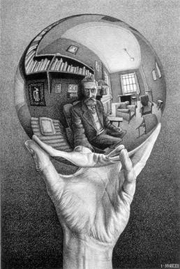 |
| Hand with Reflecting Sphere | M.C. Escher | Lithograph 1935 |
Nothing is as it seems. Your reality is not my reality, and your logic is not my logic.
Fish becoming birds, hands drawing each other, checkered patterns morphing into lizards, bees, horses, and houses. Arrangements repeated into infinity and blendings of sky, earth, and water. Fish-eyed renderings of the artist and geometric shapes viewed from several different perspectives at once. The boderline psychedelic images printed by Maurits Cornelis Escher (1898-1972) were not much appreciated in his day and long thereafter. A Dutch newspaper, Nieuwsblad van het Noorden, described Escher’s work in 1955 as “too personal, too thought-out, and too mathematical to be artistically essential” (Kersten, 2018). The public used to consider his work as non-art and, although technically perfect, not interesting enough for critics to consider. Indeed … what on Earth was Escher thinking?!
We see the world from different angles. Viewpoints have been the subject of analysis for many philosophers and other deep-thinkers throughout history. Equally so for artists of many disciplines. Perspectives in the visual arts were first made tangible by Fillipo Brunelleschi (1377-1446) in the architecture of the Baptistery of Florence. His mathematically sound, two-point linear perspective inspired other artists. His views changed the approach to art and design for centuries to come. As innovative architect, sculptor, and designer, Brunelleschi was considered the father of the Renaissance.
Just to get a little techie on you: linear perspective is a point-of-view system made up of straight lines coming together in a vanishing point. The purpose is to give three-dimensional sceneries depth on two-dimensional surfaces, making any visual more naturalistic. However, already with three-point perspective renderings, the image will start to feel more mathematical but less natural. When we get to five- and six-point perspectives, the lines even start to curve and we now deal with curvilinear systems, distorting reality. Or do they? The illustrations below give a visual explanation of these techniques.
 |
| Rectilinear and Curvilinear Perspectives | 1-5 points |
Where our rebels sought to purposely take away depth from real-life scenes and making the tableaux abstract, Escher went deeper and more realistic. His mathematical approach to perspective is astonishing. His techniques are meticulous and his ideas are precise, albeit bizarre in a pleasant way. In his later work, he uses combinations of the above mentioned perspectives to brilliantly take us through a world which has no up or down, beginning or end. His concepts are not so much mind-blowing as mind-bending. At first glance, the image feels architecturally logical but, at closer view, we quickly become hopelessly lost in fantastical scenes, taking our eyes in all directions.
These days, his eclectic work is heralded all over the world for precisely the qualities that were criticized during his life. “I too disdained him,” says Ronni Baer, curator of Boston Museum of Fine Arts, speaking of the Dutch printmaker (Shae, 2018). “And now I find him really fascinating — both as a really good printmaker and as a thinker. He was a guy obsessed with certain motifs. He worked them and worked them, and I think that's one of the signs of a real artist” (Shae, 2018). Escher’s search for profound mastery of techniques combined with fantasy and impeccable perspective-play makes his work on par with those of Picasso, Dali, and dare I say it?... our friend Leonardo. Whichever way you consider his intentions, his images are pure examples of powerful and intelligent artistry.
Kersten, E. (2018, October 27). Escher versus Art Criticism. Retrieved from Escher in het Paleis: https://www.escherinhetpaleis.nl/escher-today/escher-versus-art-criticism/
Shae, A. (2018, Februari 8). More Than Trippy Dorm Room Decor: The MFA Examines M.C. Escher's Skill And Enduring Allure. Retrieved from WBUR - The Artery: https://www.wbur.org/artery/2018/02/08/mfa-mc-escher

















